During my Ph.D. studies
at the Institute of Physics Polish Academy of Sciences in Warsaw we have
been able to obtain semiconductor self-assembled quantum dots (QDs) of
CdTe and CdMnTe in ZnTe matrix. These structures were grown by molecular
beam epitaxy using Stranski-Krastanov growth mode. My primary responsibility
was to characterize the optical properties of these QDs both on an ensemble
and single dot levels.
Major results of my Ph.D. thesis
include:
1. Single dot
spectroscopy of CdTe quantum dots.
2. Redistribution
of carriers between self - assembled quantum dots.
3. Optical characterization of
CdTe/ZnTe quantum wells. (still to come)
4. Three - dimensional
quantum dot crystal formation in CdTe/ZnTe quantum dot system.
1. Single
dot spectroscopy of CdTe QDs.
High resolution photoluminescence
is an extremely powerful method for unraveling the optical properties of
single QDs. Out of several approaches to isolate individual emitters we
have chosen to evaporate thin metal films with small apertures on top of
QD sample. Apertures were made using electron beam lithography and chemical
etching. A diameter of apertures ranged from 3 microns down to 100 nm.
Atomic force microscopy images of two masks with apertures of 100 nm and
700 nm are shown in Fig. 1.
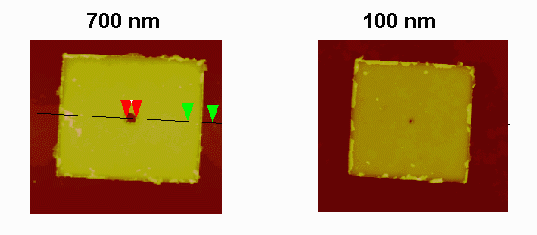 The measurements were carried out at
the University of Nijmegen within collaboration with Fabio Pulizzi and
Peter Christianen. The experimental setup allowed to collect images as
well as spectra of QDs within the apertures. Fig. 2 displays three images
showing metal masks with and without apertures. Fig. 3 shows spectrally
resolved emission of the smallest aperture at B=0T and B=3T (unpolarized).
The measurements were carried out at
the University of Nijmegen within collaboration with Fabio Pulizzi and
Peter Christianen. The experimental setup allowed to collect images as
well as spectra of QDs within the apertures. Fig. 2 displays three images
showing metal masks with and without apertures. Fig. 3 shows spectrally
resolved emission of the smallest aperture at B=0T and B=3T (unpolarized).
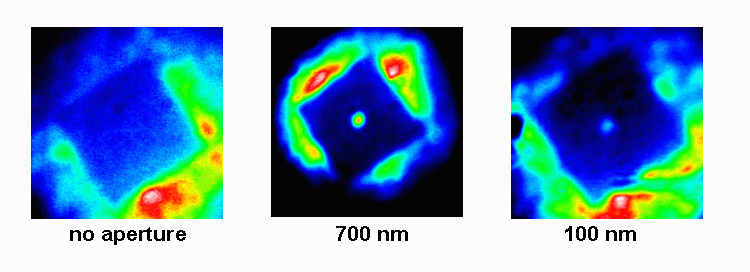
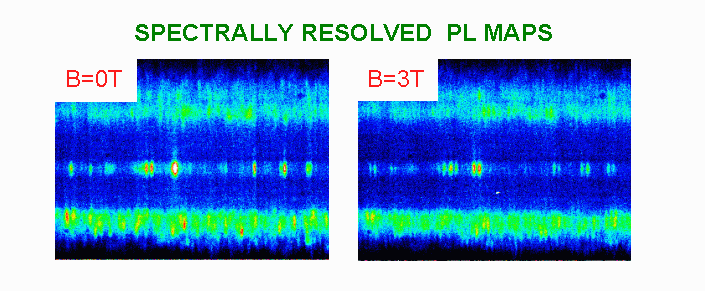 By analyzing single dot emission as
a function of magnetic field we obtained excitonic Zeeman splitting as
well as diamagnetic shifts which are invertly proportional to the exciton
size in the QD. Examples of magnetic field behavior for symmetric and elongated
single CdTe QDs are shown in Fig. 4 together with energy dependence of
the exciton effective g-factor (estimated from the Zeeman splitting). We
found that the g-factor is uniform over the ensemble.
By analyzing single dot emission as
a function of magnetic field we obtained excitonic Zeeman splitting as
well as diamagnetic shifts which are invertly proportional to the exciton
size in the QD. Examples of magnetic field behavior for symmetric and elongated
single CdTe QDs are shown in Fig. 4 together with energy dependence of
the exciton effective g-factor (estimated from the Zeeman splitting). We
found that the g-factor is uniform over the ensemble.

Publications:
S. Mackowski, J. Wróbel,
K. Fronc, J. Kossut, F. Pulizzi, P.C.M. Christianen, J.C. Maan, G. Karczewski,
"Exciton Spectroscopy of Single CdTe and CdMnTe Quantum Dots", physica
status solidi
b 229, 493 (2002)
S. Mackowski, "CdTe/ZnTe Quantum
Dots – Growth and Optical Properties", Thin Solid Films, 412,
96 (2002)
2. Redistribution
of carriers between self-assembled QDs.
The morphology of self-assembled
QDs made of II-VI compounds depends on the amount of material deposited
during the growth. As schematically displayed in Fig. 5, in the first growth
stage 2D platelets with small QDs are formed. With adding more material
the platelets form a uniform 2D wetting layer. At the end the structure
consists only of large quanutm dots.
We have shown that the morphology
strongly determines the optical properties of QDs.
 The PL spectrum of a QD structure with
2 monolayers (MLs) of CdTe features two lines, the high energy one is due
to the wetting layer, whereas the low energy one is associated with exciton
emission of QDs themselves. On the other hand, for the sample with 4 ML
of CdTe, the PL shows just a single emisson line attributable to QDs (Fig.
6). Consequently, the optical propeorties of the latter are determined
by the behavior of isolated single QDs: the energy dependence on the temperature
follows the band gap shrinkage of CdTe. Also, the decay time of the exciton
recombination shows no dependence on temperature as well as on the excitation
power (see Fig. 6).
The PL spectrum of a QD structure with
2 monolayers (MLs) of CdTe features two lines, the high energy one is due
to the wetting layer, whereas the low energy one is associated with exciton
emission of QDs themselves. On the other hand, for the sample with 4 ML
of CdTe, the PL shows just a single emisson line attributable to QDs (Fig.
6). Consequently, the optical propeorties of the latter are determined
by the behavior of isolated single QDs: the energy dependence on the temperature
follows the band gap shrinkage of CdTe. Also, the decay time of the exciton
recombination shows no dependence on temperature as well as on the excitation
power (see Fig. 6).
 Completely different behavior is observed
(see Fig. 7), when similar experiments are performed for the sample with
the wetting layer. At elevated temperatures (T>35K) the carriers confined
in smaller QDs are able to escape into the wetting layer and then to find
other QDs with presumably lower emission energy. In other words, carriers
are thermally redistributed within the ensemble of QDs. The redistribution
process strongly affects the power dependence of both the PL emission and
decay times of the exciton recombination. However, The redistribution determines
the optical properties of the QD ensemble below the temperatures, where
non-radiative recombination in the wetting layer are negligible (T<100).
Completely different behavior is observed
(see Fig. 7), when similar experiments are performed for the sample with
the wetting layer. At elevated temperatures (T>35K) the carriers confined
in smaller QDs are able to escape into the wetting layer and then to find
other QDs with presumably lower emission energy. In other words, carriers
are thermally redistributed within the ensemble of QDs. The redistribution
process strongly affects the power dependence of both the PL emission and
decay times of the exciton recombination. However, The redistribution determines
the optical properties of the QD ensemble below the temperatures, where
non-radiative recombination in the wetting layer are negligible (T<100).
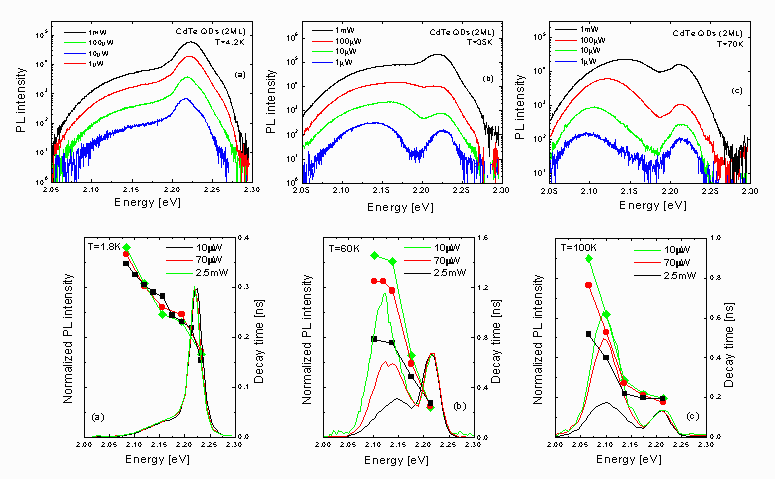 Using a simple model that assumes all
the effects are due to redistribution of carriers bettwen the QDs we have
been able to fit the temperature dependencies of the linewidth and the
emission energy measured experimentally for several constant excitation
powers.
Using a simple model that assumes all
the effects are due to redistribution of carriers bettwen the QDs we have
been able to fit the temperature dependencies of the linewidth and the
emission energy measured experimentally for several constant excitation
powers.
Publications:
S. Mackowski, F.V. Kyrychenko,
W. Heiss, G. Prechtl, G. Karczewski, J. Kossut, "Impact of Carrier Redistribution
on the Photoluminescence of CdTe Self-Assembled Quantum Dot Ensembles",
Physical Review B 69, 205325 (2004)
S. Mackowski, "CdTe/ZnTe Quantum
Dots – Growth and Optical Properties", Thin Solid Films, 412,
96 (2002)
S. Mackowski, F. Kyrychenko, G.
Karczewski, J. Kossut, W. Heiss, G. Prechtl, "Thermal Carrier Escape
and Capture in CdTe Quantum Dots", physica status solidi b 224,
465 (2001)
4. Three
- dimensional quantum dot crystal formation in CdTe/ZnTe QD system.
Since the formation of self-assembled
QDs is driven by the elastic strain, a single dot covered with a barrier
material produces a strain field on the surface. This strain field could,
under appropriate conditions, influence the position of QDs formed above
this QD. We have grown multilayer CdTe/ZnTe QD structures with thickness
of the ZnTe spacer layer varying between 3ML and 75ML. In Fig. 8 a cross-sectional
image from transmission electron microscopy of sample with 50ML thick spacer
is shown. In this case we observe no correlation between spatial positions
of QDs in neighboring layers.
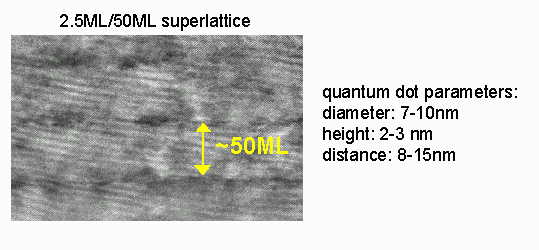 With decreasing the thickness of the
spacer the positions of QDs in subsequent layers become correlated, as
displayed in Fig. 9 for the structure with 15 ML thick ZnTe spacer layer.
The angle of this correlation is about 40 degrees. The extension of correlated
region is equal to 6 - 7 layers in growth direction and 5 - 6 islands in
the layer. A driving force for the vertical alignment is an elastic anisotropy
of the matrix material, which in the case of II–VI semiconductors is considerably
larger than for III–V compound. In the particular of ZnTe it has been predicted
that the elastic energy density exhibits four minima in <110> axis.
With decreasing the thickness of the
spacer the positions of QDs in subsequent layers become correlated, as
displayed in Fig. 9 for the structure with 15 ML thick ZnTe spacer layer.
The angle of this correlation is about 40 degrees. The extension of correlated
region is equal to 6 - 7 layers in growth direction and 5 - 6 islands in
the layer. A driving force for the vertical alignment is an elastic anisotropy
of the matrix material, which in the case of II–VI semiconductors is considerably
larger than for III–V compound. In the particular of ZnTe it has been predicted
that the elastic energy density exhibits four minima in <110> axis.
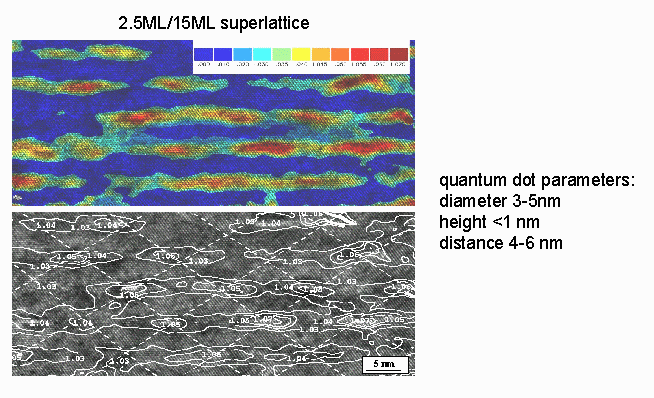 Lateral positions of QDs within the
layers has been studied using small angle X-ray scattering. A two-dimensional
image of scattering intensity along the growth direction obtained for the
sampel with 10ML ZnTe spacer is given in Fig. 10 together with extracted
profiles along two directions (as displayed).
Lateral positions of QDs within the
layers has been studied using small angle X-ray scattering. A two-dimensional
image of scattering intensity along the growth direction obtained for the
sampel with 10ML ZnTe spacer is given in Fig. 10 together with extracted
profiles along two directions (as displayed).
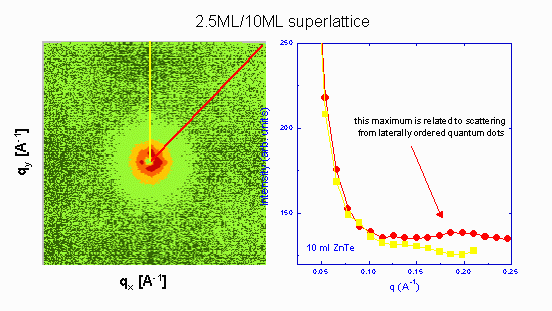 The analysis of the angular dependence
of the scattering intensity reveals four unamboigous maxima (Fig. 11).
This implies that a three-dimensional arrangement of QD positions is achived
through elastic stran field created by the dots. The observed arrangement
is in perfect agreement with theoretical predictions for ZnTe.
The analysis of the angular dependence
of the scattering intensity reveals four unamboigous maxima (Fig. 11).
This implies that a three-dimensional arrangement of QD positions is achived
through elastic stran field created by the dots. The observed arrangement
is in perfect agreement with theoretical predictions for ZnTe.
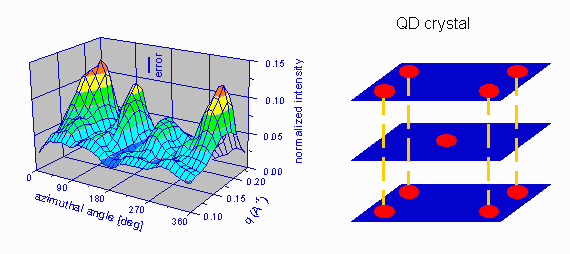 Publications:
Publications:
S. Mackowski, E. Sobczak, R. Nietubyc,
G. Goerigk, S. Kret, P. Dluzewski, A. Szczepanska, E. Janik, J. Kossut,
G. Karczewski, “Three-dimensional Quantum Dot "Crystal" Formation in
CdTe/ZnTe Superlattices", physica status solidi
b 229,
445 (2002)
S. Mackowski, G. Karczewski, J.
Kossut, G. Sek, J. Misiewicz, G. Prechtl, W. Heiss, “Optical Properties
of CdTe/ZnTe Quantum Dot Superlattices", Physica E 12, 503 (2002)
S. Mackowski, G. Karczewski, T.
Wojtowicz, J. Kossut, A. Szczepanska, S. Kret, P. Dluzewski, G. Prechtl,
W. Heiss, "Structural and Optical Evidence of Island Correlation in
CdTe/ZnTe Superlattices", Applied Physics Letters
78, 3884 (2001)
M. Godlewski, S. Mackowski, G.
Karczewski, E.M. Goldys, M.R. Phillips, "Scanning Cathodoluminescence
and Electron Microscopy of Self-Organized CdTe Quantum Dots", Semiconductor
Science and Technology 16, 493 (2001)
S. Kret, P. Dluzewski, A. Szczepanska,
S. Mackowski, T. Wojtowicz, G. Karczewski, J. Kossut, P. Dluzewski, P.
Traczykowski, P. Ruterana, "Electron Microscopy Study of ZnTe/CdTe Superlattices
with High Density of Quantum Dots", Materials Research Society Symposium
Proceedings 642, J3.8.1 (2001)
R. Nietubyc, E. Sobczak, J.B. Pelka,
S. Mackowski, E. Janik, G. Karczewski, ”Anomalous Small Angle X-Ray
Scattering Study of CdTe Quantum Dots in ZnTe", Journal of Alloys and
Compounds
328, 206 (2001)











